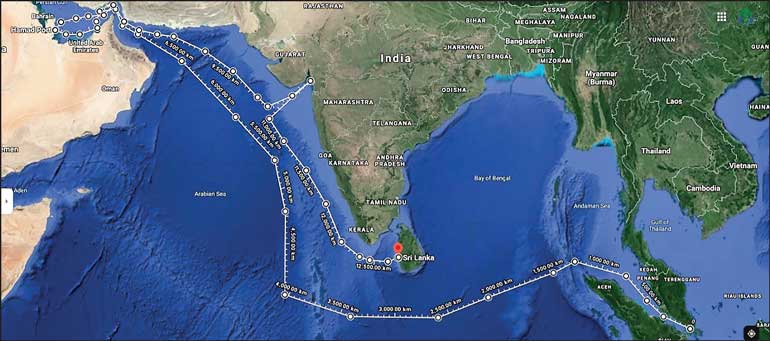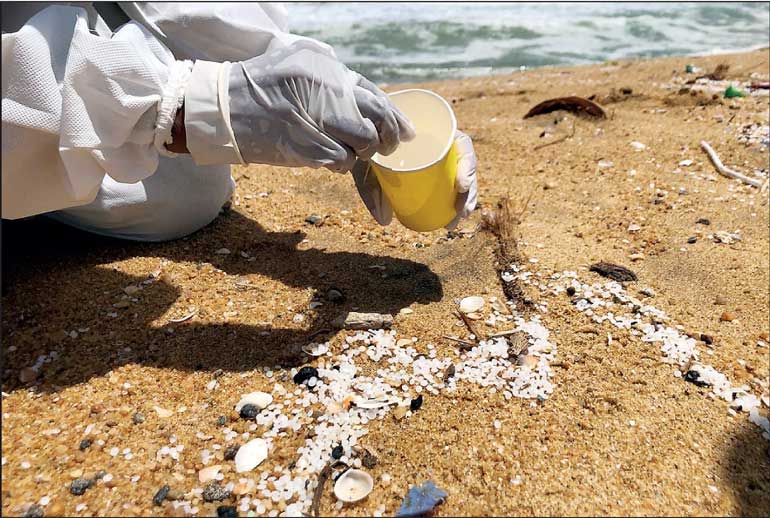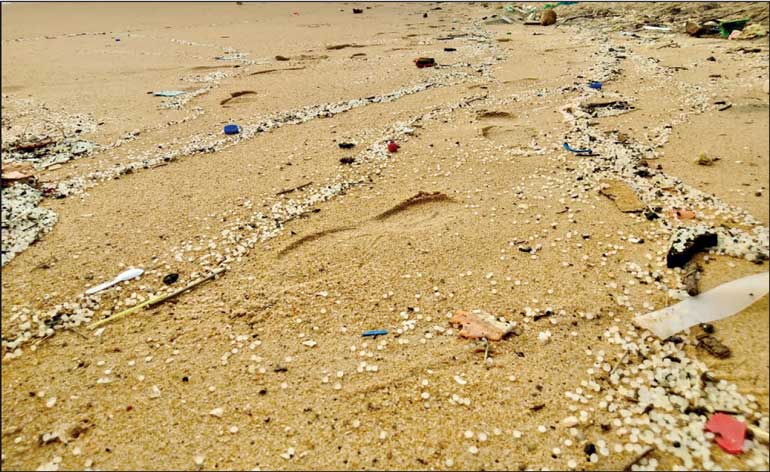Tuesday Apr 22, 2025
Tuesday Apr 22, 2025
Monday, 13 September 2021 00:00 - - {{hitsCtrl.values.hits}}

X-Press Feeders operates a route that includes Singapore, Jebel Ali (United Arab Emirates), Port Hamad (Qatar), Hazira (Gujarat, India), Colombo, and Port Kelang and Tanjung Pelepas (Malaysia). Map design credits: John Wilson

Lentil-sized nurdles mixed with seashells on Mount Lavinia beach – Image credit: Maleesha Gunawardana

Nurdles spread across the Negombo coastline weeks after the incident. Image credit – Avishka Sendanayake

Carcass washed up on Moratuwa beach on 7 July – Image credits: Shalanka Ranjula
Sri Lanka is currently facing the worst man-made maritime disaster to date after the chemical-laden MV X-Press Pearl, a Singapore-flagged container ship, caught fire on 21 May while it was anchored approximately nine nautical miles (NM) northwest of Colombo.
miles (NM) northwest of Colombo.
The ship’s cargo was mainly plastics, chemicals and dangerous goods. According to the cargo manifest, a total of 1,486 containers were aboard the ship consisting of 445 containers of plastics/rubbers, 120 containers of chemicals and allied industries, 81 dangerous goods, 568 other goods and 272 empty containers.
The route taken by the X-Press Pearl indicates several stops at international ports before arriving in Colombo. The timeline and route are highlighted in the following map.
Detailed below is the timeline of the incident which resulted in the X-Press Pearl shipwreck.
20 May: Smoke was reported in the cargo hold. Following the report, emergency procedures were undertaken which released carbon dioxide into the cargo hold. Simultaneously the port control and local authorities were informed which resulted in firefighting teams and Navy assets being placed on standby.
21 May: The initial report of the fire on deck. Firefighting teams and a helicopter were deployed to manage the fire.
22 May: The initial report from the crew of an explosion in the cargo hold. Firefighting operations continued.
23 May: The 12 crew members were disembarked from the vessel, allowing a firefighting team of 12 members to enter. Firefighting operations continued.
24 May: The fire intensified and was reported to have reached the tail of the vessel.
25 May: The second explosion was reported around noon, it was louder and resulted in the evacuation of the remaining crew members and the firefighting team. They were all transferred to a quarantine facility while two were sent to the hospital due to leg injuries during the evacuation. 10 containers fell into the sea.
26 May: Firefighting operations continued with Sri Lankan Navy vessels and helicopters as well as two Indian coast guard vessels. The debris and nurdles that were released to the sea during the explosions started reaching the shoreline of Sri Lanka. Three JCB diggers were provided to the Marine Environment Protection Authority (MEPA) to be used to clean the shoreline and to be used by the defence forces mobilised for the cleaning.
27 May: All relevant personnel continued to be present on sight to extinguish the fire and it was reported that it has diminished to an extent.
31 May: A decision was made to tow the boat to a refuge site located 50 NM west of the coastline to minimise impacts on other maritime shipping and the coastal environment.
1 June: The engine room was reported to be flooded by an inspection team of salvors on board the vessel. The report highlighted concerns over the ship's stability due to the amount of water present. MEPA orders the vessel to be towed out to the deep sea. Several failed attempts at towing were reported and the operation was aborted due to safety concerns.
2 June: Further efforts to tow the ship to deeper waters also failed and the ship’s tail end sank to the bottom of the ocean at about 21 metres and 9.5 NM off the coast of Colombo. The front end of the ship remains afloat with continuous smoke being released from cargo hold 1 and 2. Oil spill response teams remain on standby.
4 June: Salvors retrieve the anchor.
6 June: Reports made by the Navy divers highlight that they retrieved the vessel's Voyage Data Recorder and note that there were no signs of debris or fuel oil spill.
The environmental impact
Unprecedented pellet spill
According to independent estimates, close to 75 billion low-density polyethylene (LDPE), linear low-density polyethylene (LLDPE) and possibly high-density polyethylene (HDPE) plastic pellets were spilt into the ocean from the distressed vessel. Plastic pellets, also colloquially referred to as ‘nurdles’, are the raw materials that are melted down to produce nearly all plastic products. Weighing merely a fraction of an ounce, at a size of 5mm or less, nurdles are considered primary microplastics that are originally manufactured for commercial use.
Being lightweight and buoyant, the nurdles have spread across the western, southern and northwestern coasts of Sri Lanka. In due course, this is bound to become a regional problem since ocean currents and wind speeds will continue to disperse. According to a computer-generated model shared by Prof. Charitha Pattiaratchi from the University of Western Australia, the nurdles will make landfall in many of the Indian Ocean countries (Indonesia, India, Somalia and Maldives) due to the reversing monsoon currents in the region.
When nurdles spill into the ocean, they absorb pollutants that have moved into our seas through land runoff, such as persistent organic pollutants (POPs). According to the World Health Organization (WHO), the most commonly encountered POPs, such as polychlorinated biphenyls (PCB), organochlorine pesticides and industrial chemicals, can have significant negative impacts on the environment and human health.
Even though plastic, as a raw material, is popular for its versatility, what is not so popular are the ingredients added in the manufacturing process that make plastic so versatile and colourful. These ingredients consist of fossil fuel contaminants, additives such as dyes, bisphenol A (BPA), phthalates and plasticisers.
When marine animals consume these lentil-sized nurdles by mistaking them for food such as fish eggs or roe, the toxic chemicals inside can leach out and bioaccumulate or build up in their cells and tissues. The ingestion of nurdles alone could block their digestive tracts, leading to starvation and death.
While more than 100,000 marine mammals are killed every year by macro-plastic ingestion or entanglement, a study published in the Environmental Pollution journal in 2018 suggests that even particles as small as 5mm could push these animals further to the brink of extinction as microplastics and chemicals can be passed from one trophic level to the next throughout the food chain.
The predicted immediate impacts of the recent maritime disaster in Sri Lanka were apparent, as lifeless fish washed up with nurdles lodged inside their gills and mouths. A vast number of other marine wildlife, including sea turtles, were also found dead on beaches in several parts of the island. However, whether the nurdles were a cause of death is yet to be determined in the absence of necropsy results.
The nurdles and other microplastics can also have long-term effects on sea turtle nesting beaches, by potentially altering the temperature and permeability of sand. This would impact sea turtle populations, as the gender of hatchlings is temperature-dependent.
Nurdles were also observed floating and accumulated to the banks of the Negombo Lagoon in Western Province, where an extensive Coastal Mangrove Forest is present, within which spawning sites for a multitude of marine species are found. The accumulation of nurdles could have had an impact on such species as well.
Marine animal deaths
Sri Lankan waters are home to five out of the seven species of sea turtles and thus far five species have been found lifeless on the Sri Lankan shores, namely; Leatherback sea turtles (the largest turtles on Earth), Olive Ridley sea turtles, Green sea turtles, Loggerhead sea turtles and Hawksbill sea turtles.
According to the information submitted by a government analyst’s report, deaths of 417 sea turtles, 48 dolphins and eight whales have been recorded as of 30 July. Even though the official necropsy results are yet to be released, statements made by the relevant ministries and expert committees indicate that the deaths were linked to the pollution caused by the ship.
Independent researchers/experts such as Ranil Nanayakkara have also kept records of the marine deaths and the latest data according to his scores indicate that carcasses of 426 turtles, 58 dolphins, 11 whales and 31 sea snakes have been recorded along the coasts of Sri Lanka since the shipwreck.
A variety of fish species were also found along the coastlines, which included carcasses of Pufferfish and Moray Eels.
A toxic concoction
Aboard the ship were about 81 containers of dangerous goods carrying 15 different types of dangerous goods according to the International Maritime Dangerous Goods Code (IMDG Code). The spill of Hazardous and Noxious Substances (HNS) identified in the cargo manifest raised serious concerns on the potential impact on the marine environment.
While several HNS such as nitric acid, caustic soda, methanol, sodium methoxide, sodium methylate, vinyl acetate are either flammable and/or soluble substances that could have been burnt during the fire or dissolved in the water, the severity of the nitric acid (25 tons) and caustic soda (1040 tons) spillage cannot be overstated.
Following the disaster, a UN team of oil spill and chemical experts worked with the Sri Lankan Government to assess the impact on the environment caused by the MV X-Press Pearl disaster by providing technical advisory support to the Sri Lankan experts on oil spill contingency planning, clean-up operations and environmental impact assessment. The team produced an independent report of the incident with key findings and recommendations on short-term response measures and longer-term recovery planning and submitted it to the Government.
According to the aforementioned Report of the UN Environmental Advisory Mission (July 2021), while both nitric acid and caustic soda are soluble, they may sink into the seawater column since their density is higher than that of seawater, hence may have collectively formed a corrosive plume on the seabed. Thus, the observations of “bleached” and “burnt” carapaces of the dead sea turtles that washed up following the disaster could be due to their contact with the moving plume of nitric acid and/or caustic soda. The report also denotes that the containers of methanol (210 tons) on the upper deck probably burnt off during the fire causing the reported explosions. The methanol that burnt off during the fire may also explain the reported explosions as its container was located on the upper deck.
While epoxy resin which accounts for one-third of the cargo (9,700 tonnes in 349 containers) is not listed as a dangerous good in the cargo manifest, it could pose a threat to the marine environment particularly in the form of liquid. However, the cargo manifest does not specify whether epoxy resin was in the form of liquid, solid, paste or gel.
Epoxy resin is generally used in the manufacture of adhesives, plastics, paints etc. In liquid form, epoxy resin could potentially create a plume close to the seafloor which can be toxic to aquatic life while also posing a threat to marine fauna with long-term impacts.
The question of oil
An oil spill was much anticipated from the distressed vessel that carried 348 tonnes of bunker oil since it began to sink. A continuous release of oil emanating from the MV X-Press Pearl had been detected by the UN team from both satellite and on-site observations since 8 June.
The presence of bunker oil, which was identified to be an Intermediate Fuel Oil 380 (IFO 380), was confirmed to be IFO by the laboratory analysis of the oil sample collected near the wreck by the Centre of Documentation, Research and Experimentation on Accidental Water Pollution (CEDRE) in France. The oil on board the MV X-Press Pearl has been identified as a mixture of approximately 95% of Heavy Fuel Oil (HFO) and 5% gasoline. As HFO is dense, it’s blended with lighter fuels like gasoline to achieve the required specifications.
When all refined products have been extracted from crude oil, the residue which is a tar-like substance is referred to as HFO. The same product is known by other technical names such as bunker oil, marine fuel, furnace oil, fuel oil, Number 6 Fuel Oil (Bunker C), etc. HFO is widely used by ocean-bound vessels that comprise cargo ships, cruise ships, ferries, oil tankers and bulk carriers as it is about 30% cheaper than the alternate lighter marine fuels. The physical properties of HFO include impermeability, elasticity and fire resistance.
IFO 380 in the vessel, therefore, has a limited probability to have burnt in the fire, hence the UN team concludes that a substantial residual quantity of oil may be present in the fuel tanks which are located in the vessel’s lower part below the waterline. The drifting slick of oil is said to either evaporate due to weather conditions or drift towards the beaches where they will either be mechanically eroded by friction with the sand grains or get buried in the sand.
Following the observations, the Marine Environment Protection Authority (MEPA) of Sri Lanka (the agency responsible for preventing, controlling and managing marine pollution in Sri Lankan waters under the Marine Pollution Prevention Act No. 35 of 2008) implemented the National Oil Spill Contingency Plan (NOSCP).
NOSCOP divides oil spill response into three categories based on the amount of oil spilt and the proximity to a response centre: tier I involves relatively small spills of up to 50 tonnes; tier II includes spills that ranges from 50 to 100 tonnes; and tier III addresses leakage of more than 100 tonnes, which require international assistance to combat the spills. The resources under MEPA include several oil booms, dispersants, chemical response kits, a spray machine and a decontamination unit while combined resources of other stakeholders include skimmers, foam, pumps and temporary portable storage.
Air pollution
Smoke resulting from the fire and explosion of the MV X-Press Pearl lasted around 10 days and could be visible from the Western Provincial coast, which resulted in significant air pollution. When considering the chemical containers on board the ship, the smoke is believed to have a concoction of pollutants comprising nitrogen oxides, sulphur dioxide, soot, particulate matter, carbon monoxide and a range of hydrocarbons as well as dioxins, furans, and heavy metals.
According to a mapping conducted by the National Building Research Organisation (NBRO) using limited primary data, the total spread of the smoke was at 120 square kilometres (km2) and reached the Western Province as well, which is one of the highly populated regions in the country. Further tests on the impact of these chemicals after reaching the upper atmosphere are difficult to determine as time has passed to research the area. However, it would be a difficult task as other pollutants could also result in acid rains, constantly being produced and released into the atmosphere via anthropogenic means.
(To be continued)
(The writers can be contacted via [email protected] and [email protected])
Discover Kapruka, the leading online shopping platform in Sri Lanka, where you can conveniently send Gifts and Flowers to your loved ones for any event including Valentine ’s Day. Explore a wide range of popular Shopping Categories on Kapruka, including Toys, Groceries, Electronics, Birthday Cakes, Fruits, Chocolates, Flower Bouquets, Clothing, Watches, Lingerie, Gift Sets and Jewellery. Also if you’re interested in selling with Kapruka, Partner Central by Kapruka is the best solution to start with. Moreover, through Kapruka Global Shop, you can also enjoy the convenience of purchasing products from renowned platforms like Amazon and eBay and have them delivered to Sri Lanka.
Discover Kapruka, the leading online shopping platform in Sri Lanka, where you can conveniently send Gifts and Flowers to your loved ones for any event including Valentine ’s Day. Explore a wide range of popular Shopping Categories on Kapruka, including Toys, Groceries, Electronics, Birthday Cakes, Fruits, Chocolates, Flower Bouquets, Clothing, Watches, Lingerie, Gift Sets and Jewellery. Also if you’re interested in selling with Kapruka, Partner Central by Kapruka is the best solution to start with. Moreover, through Kapruka Global Shop, you can also enjoy the convenience of purchasing products from renowned platforms like Amazon and eBay and have them delivered to Sri Lanka.